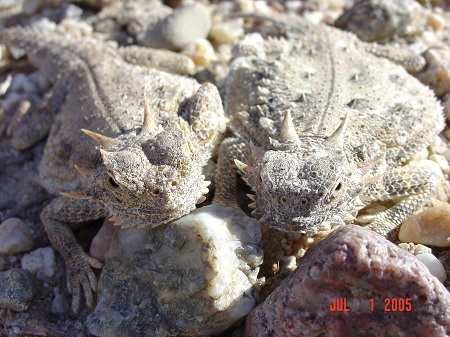 What’s the strangest thing you’ve done in the pursuit of scientific knowledge? Oliver Hay tasted blood squirted from the eye of a live horned lizard specimen sent to the Field Museum from California in 1891. While we advise against going to such lengths, we do recommend getting to know the horned lizards, genus Phrynosoma (from the Greek: toad-body). Known colloquially as “horned toads” or “horny toads” due to their round, flat body shape, spiny scales, and bony horns encircling the head, horned lizards have many unique traits worthy of study.
What’s the strangest thing you’ve done in the pursuit of scientific knowledge? Oliver Hay tasted blood squirted from the eye of a live horned lizard specimen sent to the Field Museum from California in 1891. While we advise against going to such lengths, we do recommend getting to know the horned lizards, genus Phrynosoma (from the Greek: toad-body). Known colloquially as “horned toads” or “horny toads” due to their round, flat body shape, spiny scales, and bony horns encircling the head, horned lizards have many unique traits worthy of study.
Of the 22 species in the genus Phrynosoma, 4 occur in California. Phrynosoma mcallii, the flat-tailed horned lizard, is federally endangered and is restricted to sandy habitat in the Colorado Desert. P. blainvillii, coast horned lizard, is a California Species of Special Concern found in the south and central Coast Range, and inland to the Sierra foothills. P. platyrhinos, the desert horned lizard, is found throughout the Colorado and Mojave deserts (southern subspecies) and in eastern Modoc and Lassen counties (northern subspecies). Finally, P. douglasii, the pygmy short-horned lizard, is a tiny species whose range barely dips into the northeastern corner of our state.
 Horned lizards are relatively easy to observe; rather than fleeing predators, they may rely on a variety of avoidance mechanisms including camouflage, partial burial in sand, or defensive postures that make them difficult to swallow (but impressive to photograph—see photo at left). Of the California species, only P. blainvillii is known to exhibit the blood-squirting defense mechanism, so keep that in mind the next time you reach for a horned lizard. Many Phrynosoma species depend on ants as their primary food source, a factor which may be contributing to their decline in regions where invasive insects are replacing native harvester ants.
Horned lizards are relatively easy to observe; rather than fleeing predators, they may rely on a variety of avoidance mechanisms including camouflage, partial burial in sand, or defensive postures that make them difficult to swallow (but impressive to photograph—see photo at left). Of the California species, only P. blainvillii is known to exhibit the blood-squirting defense mechanism, so keep that in mind the next time you reach for a horned lizard. Many Phrynosoma species depend on ants as their primary food source, a factor which may be contributing to their decline in regions where invasive insects are replacing native harvester ants.
Have you witnessed any incredible horned lizard behavior? Send us your observations of P. mcallii and P. blainvillii via our  Online Field Survey Form-- and feel free to attach photographic evidence; your picture could be featured in our next Photo of the Month!
Online Field Survey Form-- and feel free to attach photographic evidence; your picture could be featured in our next Photo of the Month!
Photo credit: California Department of Parks and Recreation (Eric Hollenbeck), Joseph Belli